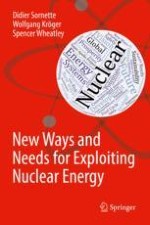2019 | OriginalPaper | Chapter
6. Candidate Features and Technology Options
Authors : Didier Sornette, Wolfgang Kröger, Spencer Wheatley
Published in: New Ways and Needs for Exploiting Nuclear Energy
Publisher: Springer International Publishing
Activate our intelligent search to find suitable subject content or patents.
Select sections of text to find matching patents with Artificial Intelligence. powered by
Select sections of text to find additional relevant content using AI-assisted search. powered by
